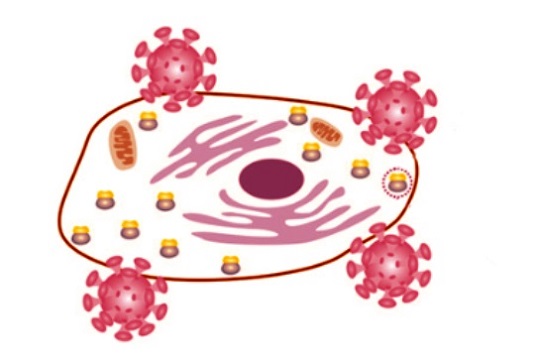French Scientists Find That SARS-CoV-2 NSP-1 Protein Hijacks Human Ribosomes to Multiply and Suppress Immunity
Nikhil Prasad Fact checked by:Thailand Medical News Team May 24, 2025 7 months, 9 hours, 31 minutes ago
Medical News: Scientists Uncover How the Virus Rewires Our Cells
Researchers from the Architecture et Réactivité de l’ARN lab at CNRS UPR9002, Institut de Biologie Moléculaire et Cellulaire, Université de Strasbourg in France have uncovered remarkable new details about how the SARS-CoV-2 virus takes control of a human cell’s protein-making machinery to reproduce itself and disable the body’s immune defenses. Their study provides critical insights into the sophisticated strategies the virus uses to thrive and how it manages to evade being shut down by our cells' protective responses. This
Medical News report will break down these complex mechanisms into easy-to-understand concepts for the general public.
 French Scientists Find That SARS-CoV-2 NSP-1 Protein Hijacks Human Ribosomes to Multiply and Suppress Immunity
Viral Blueprint Hijacks Cellular Machinery
French Scientists Find That SARS-CoV-2 NSP-1 Protein Hijacks Human Ribosomes to Multiply and Suppress Immunity
Viral Blueprint Hijacks Cellular Machinery
At the heart of the SARS-CoV-2 virus’s success lies its ability to manipulate a vital process in human cells known as translation—the step where genetic messages in RNA are used to make proteins. Proteins are essential for all life processes, and cells rely on ribosomes, a sort of microscopic factory, to build them. Once the virus enters the human cell, it releases its genetic material—a single strand of RNA—and this RNA serves directly as instructions for building new viral proteins. To do this, the virus must hijack the host’s ribosomes, diverting them from their normal duties to work solely on producing viral components.
NSP1 Shuts Down Human Protein Production
One key viral protein responsible for this manipulation is called NSP1. It is among the first proteins the virus makes and is specifically designed to shut down the host cell’s ability to make its own proteins. NSP1 acts like a plug that blocks the entry point on the ribosome where RNA normally goes, preventing the host's RNA from being read. However, viral RNA contains a unique structure called SL1 that somehow allows it to bypass this blockage. This means while the human cell is silenced, the virus's own RNA is still being translated efficiently.
SL1 Structure Gives Virus a Competitive Edge
Interestingly, this SL1 structure is found at the beginning of every viral RNA strand, whether it codes for structural components like the spike or envelope proteins or for replication machinery. This built-in advantage ensures the virus can keep replicating while host cell defenses are paralyzed. The researchers also discovered that the SL1 and NSP1 seem to have co-evolved, developing a highly specific interaction that benefits the virus.
Virus Tricks Ribosomes with Frameshifting
The study also highlights a unique feature of viral replication called "frameshifting," where the ribosome is tricked into reading the genetic code in a different way. This allows a single viral RNA sequence to produce mu
ltiple proteins by shifting the reading frame at a specific point. SARS-CoV-2 uses a structure called the Programmed –1 Frameshift Stimulation Element (PFSE) to do this. The PFSE creates tension in the RNA and ribosome complex, forcing the ribosome to slip and produce a longer protein that is essential for virus replication.
NSP1 Blocks the Immune Alarm System
Aside from its role in shutting down host translation, NSP1 also interferes with the body’s antiviral immune system. Normally, when a virus infects a cell, it triggers the production of interferons—proteins that warn neighboring cells and activate defensive genes. NSP1 blocks multiple steps in this interferon signaling pathway. It not only stops the production of these vital messages but also blocks their translation and export from the nucleus.
Cutting Up Cellular Defenses
Moreover, NSP1 seems to call in reinforcements by recruiting unidentified enzymes that cut up host RNA, adding another layer of translation shutdown. This leaves the cell defenseless while the virus continues to thrive. Even more alarming, different strains of SARS-CoV-2 show mutations in the NSP1 protein that can make it even more efficient in dodging immune responses.
Some Host Genes Manage to Escape
Interestingly, not all human RNA is equally affected. Some RNA molecules, especially those related to the cell’s own translation machinery, seem to escape NSP1’s attack. Scientists believe this might be because the virus needs these host proteins to keep ribosomes functioning properly for its own use.
Conclusion
In conclusion, the study shows that SARS-CoV-2 has evolved highly advanced methods to dominate the host's cellular machinery. By shutting down the host’s protein production, evading immune responses, and ensuring its own RNA gets priority access to ribosomes, the virus maximizes its replication potential. Understanding these interactions between NSP1, SL1, and the host cell opens the door to designing targeted antiviral therapies that could block this hijacking process without harming the body’s normal functions. The potential for this knowledge to drive new drug development could be crucial in fighting not only SARS-CoV-2 but also other future viral threats that might use similar tactics.
The study findings were published in the peer reviewed journal: FEBS Open Bio
https://febs.onlinelibrary.wiley.com/doi/10.1002/2211-5463.13413
For the latest COVID-19 News, keep on logging to Thailand
Medical News.
Read Also:
https://www.thailandmedical.news/news/sars-cov-2-nsp1-protein-stalls-human-dna-replication-contributing-to-dangerous-long-term-health-issues
https://www.thailandmedical.news/news/swiss-study-reveals-shocking-role-of-sars-cov-2-protein-nsp1-in-silently-destroying-human-genes
https://www.thailandmedical.news/news/new-insights-into-sars-cov-2-nsp12-activity
https://www.thailandmedical.news/articles/coronavirus
https://www.thailandmedical.news/pages/thailand_doctors_listings
